2017 KIA CARENS RHD instrument panel
[x] Cancel search: instrument panelPage 11 of 723
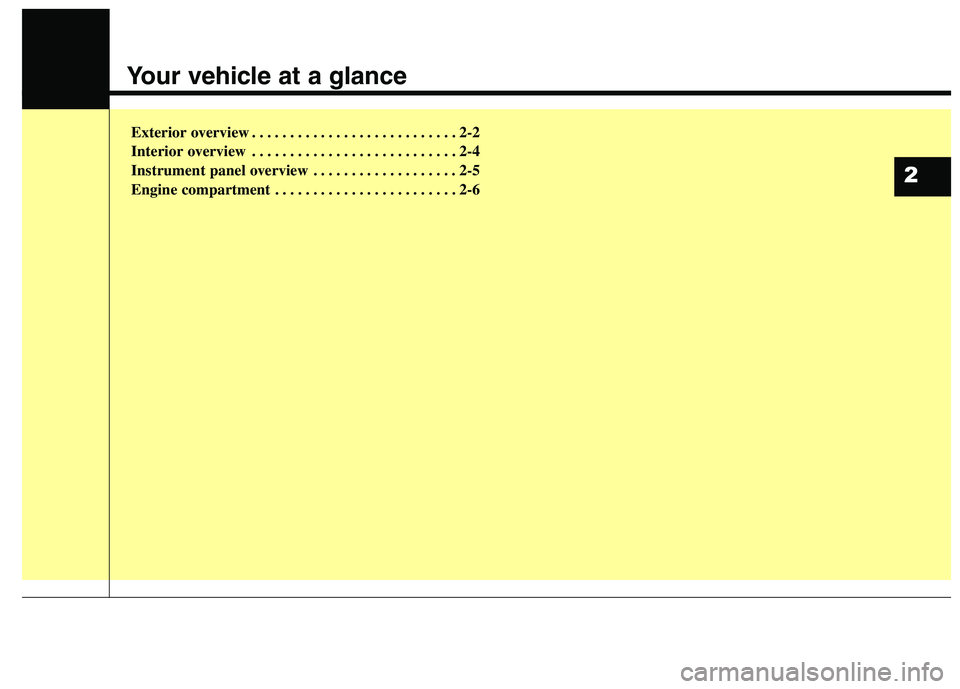
Your vehicle at a glance
Exterior overview . . . . . . . . . . . . . . . . . . . . . . . . . . . 2-2
Interior overview . . . . . . . . . . . . . . . . . . . . . . . . . . . 2-4
Instrument panel overview . . . . . . . . . . . . . . . . . . . 2-5
Engine compartment . . . . . . . . . . . . . . . . . . . . . . . . 2-6
2
Page 14 of 723
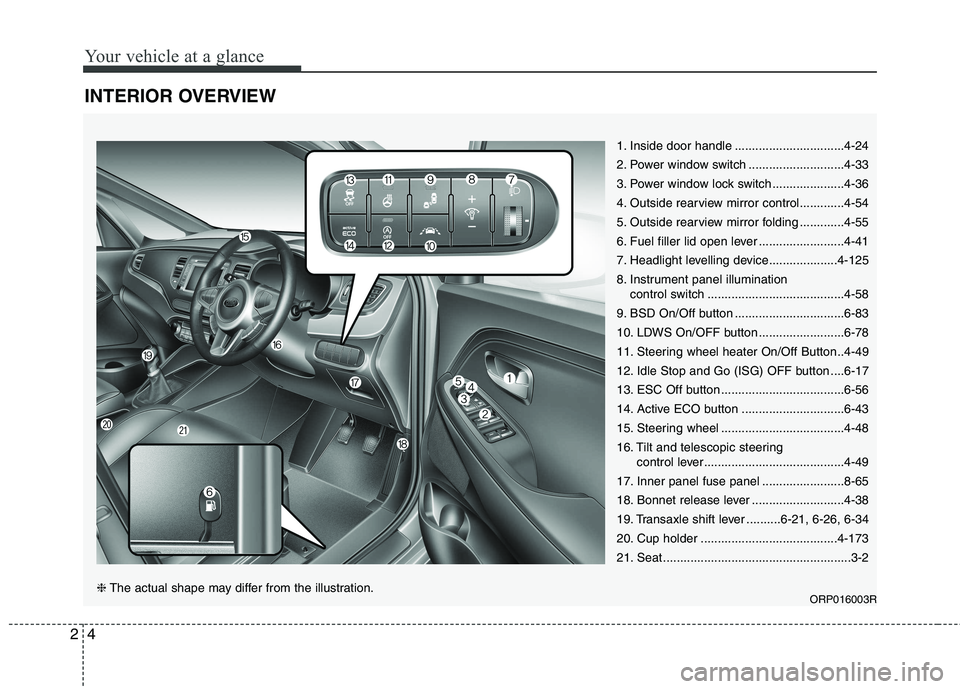
Your vehicle at a glance
4
2
INTERIOR OVERVIEW
1. Inside door handle ................................4-24
2. Power window switch ............................4-33
3. Power window lock switch .....................4-36
4. Outside rearview mirror control.............4-54
5. Outside rearview mirror folding .............4-55
6. Fuel filler lid open lever .........................4-41
7. Headlight levelling device....................4-125
8. Instrument panel illumination
control switch ........................................4-58
9. BSD On/Off button ................................6-83
10. LDWS On/OFF button .........................6-78
11. Steering wheel heater On/Off Button..4-49
12. Idle Stop and Go (ISG) OFF button ....6-17
13. ESC Off button ....................................6-56
14. Active ECO button ..............................6-43
15. Steering wheel ....................................4-48
16. Tilt and telescopic steering control lever.........................................4-49
17. Inner panel fuse panel ........................8-65
18. Bonnet release lever ...........................4-38
19. Transaxle shift lever ..........6-21, 6-26, 6-34
20. Cup holder ........................................4-173
21. Seat .......................................................3-2
ORP016003R
❈The actual shape may differ from the illustration.
Page 15 of 723
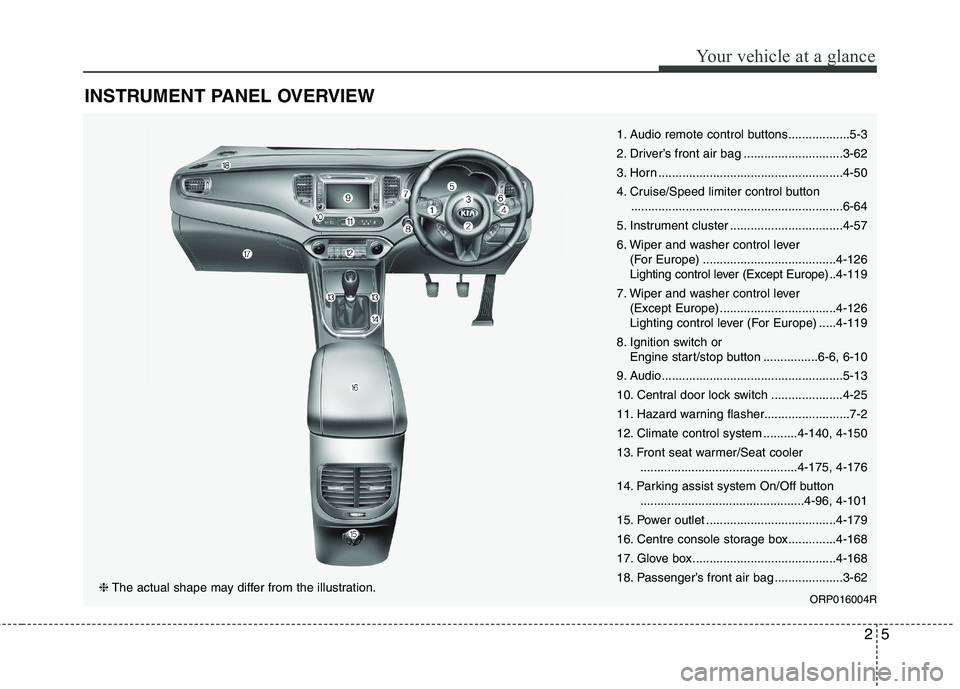
25
Your vehicle at a glance
INSTRUMENT PANEL OVERVIEW
1. Audio remote control buttons..................5-3
2. Driver’s front air bag .............................3-62
3. Horn ......................................................4-50
4. Cruise/Speed limiter control button..............................................................6-64
5. Instrument cluster .................................4-57
6. Wiper and washer control lever (For Europe) .......................................4-126
Lighting control lever (Except Europe) ..4-119
7. Wiper and washer control lever (Except Europe) ..................................4-126
Lighting control lever (For Europe) .....4-119
8. Ignition switch or Engine start/stop button ................6-6, 6-10
9. Audio.....................................................5-13
10. Central door lock switch .....................4-25
11. Hazard warning flasher.........................7-2
12. Climate control system ..........4-140, 4-150
13. Front seat warmer/Seat cooler ..............................................4-175, 4-176
14. Parking assist system On/Off button ................................................4-96, 4-101
15. Power outlet ......................................4-179
16. Centre console storage box..............4-168
17. Glove box ..........................................4-168
18. Passenger’s front air bag ....................3-62
ORP016004R
❈The actual shape may differ from the illustration.
Page 25 of 723

37
Safety features of your vehicle
3. To use the front passenger’s seat,lift and pull the seatback backward
by pulling on the folding lever.
Pull the seatback firmly until it
clicks into place. Make sure the
seatback is locked in place.Seat cushion height (if equipped)
To change the height of the seat
cushion, push the lever upwards or
downwards.
To lower the seat cushion, push down the lever several times.
To raise the seat cushion, pull up the lever several times. Front seat adjustment - power (if equipped)
The driver’s seat can be adjusted by
using the control switches located onthe outside of the seat cushion.
Before driving, adjust the seat to theproper position so as to easily con-
trol the steering wheel, pedals and
switches on the instrument panel.
WARNING
Do not fold the front passen- ger’s seat, if the occupants in
the 2nd row centre and front
passenger’s side seats. It may
cause the injury to occupants
by the seat device.
Be careful not to pinch your hands or fingers on the seat
device, when you fold or unfold.
ORP036004R
WARNING
The power seat is operable with
the ignition OFF.
Therefore, children should never
be left unattended in the car.
Page 75 of 723
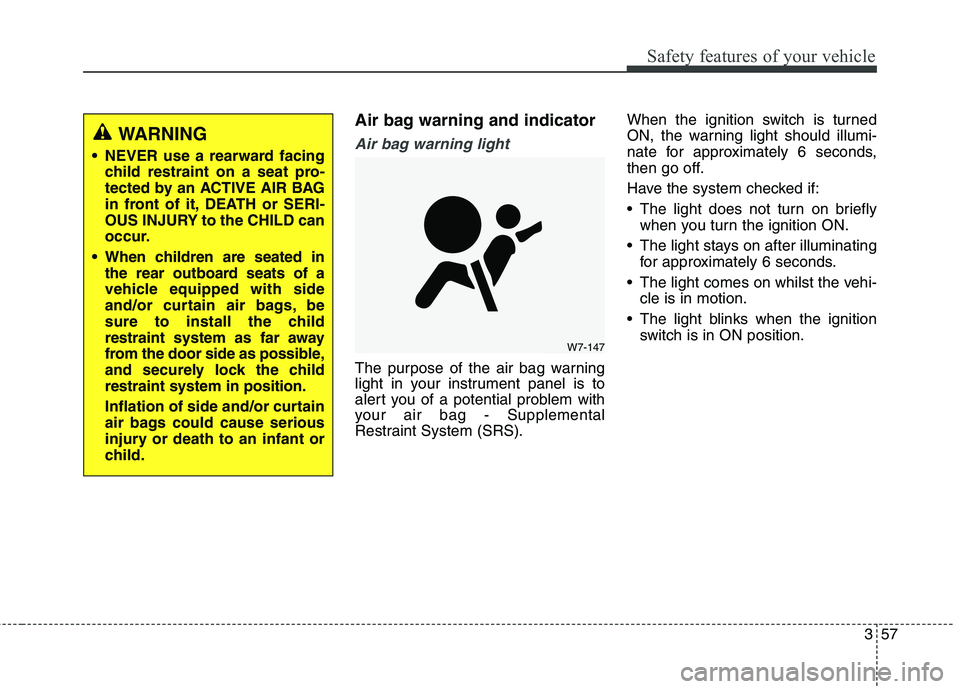
357
Safety features of your vehicle
Air bag warning and indicator
Air bag warning light
The purpose of the air bag warning
light in your instrument panel is to
alert you of a potential problem with
your air bag - Supplemental
Restraint System (SRS).When the ignition switch is turned
ON, the warning light should illumi-
nate for approximately 6 seconds,
then go off.
Have the system checked if:
The light does not turn on briefly
when you turn the ignition ON.
The light stays on after illuminating for approximately 6 seconds.
The light comes on whilst the vehi- cle is in motion.
The light blinks when the ignition switch is in ON position.
W7-147
WARNING
NEVER use a rearward facing child restraint on a seat pro-
tected by an ACTIVE AIR BAG
in front of it, DEATH or SERI-
OUS INJURY to the CHILD can
occur.
When children are seated in the rear outboard seats of a
vehicle equipped with side
and/or curtain air bags, be
sure to install the child
restraint system as far away
from the door side as possible,
and securely lock the childrestraint system in position.
Inflation of side and/or curtain
air bags could cause serious
injury or death to an infant or
child.
Page 77 of 723

359
Safety features of your vehicle
SRS components and functions
The SRS consists of the following components:
1. Driver's front air bag module
2. Passenger's front air bag module
3. Side air bag modules*
4. Curtain air bag modules*
5. Retractor pre-tensioner assemblies
6. Air bag warning light
7. SRS control module (SRSCM)
8. Front impact sensors
9. Side impact sensors*10. Passenger’s front air bag
ON/OFF indicator*
11. Passenger’s front air bag ON/OFF switch*
12. EFD (Emergency Fastening Device)*
* : if equipped
The SRSCM continually monitors all
elements whilst the ignition switch is
ON to determine if a frontal, near-frontal impact or side impact is
severe enough to require air bag
deployment or pre-tensioner seat belt
deployment.
The SRS air bag warning light on the
instrument panel will illuminate forabout 6 seconds after the ignition
switch is turned to the ON position,
after which the air bag warning lightshould go out.
ORP036093R
WARNING
If any of the following condi-
tions occurs, this indicates a
malfunction of the SRS. We rec-ommend that the system be
inspected by an authorised Kia
dealer.
The light does not turn on briefly when you turn the igni- tion ON.
The light stays on after illumi- nating for approximately 6seconds.
The light comes on whilst the vehicle is in motion.
The light blinks when the igni- tion switch is in ON position.
Page 79 of 723

361
Safety features of your vehicle
WARNING
Do not install or place any accessories (drink holder, CD
holder, sticker, etc.) on the
front passenger's panel above
the glove box in a vehicle with
a passenger's air bag. Such
objects may become danger-
ous projectiles and cause
injury if the passenger's air
bag inflates.
(Continued)
(Continued)
When installing a container ofliquid air freshener inside the
vehicle, do not place it near
the instrument cluster nor on
the instrument panel surface.
It may become dangerous pro-
jectiles and cause injury if the
passenger's air bag inflates.
OQL036109R
Passenger’s front air bag (if equipped)
WARNING
If an air bag deploys, there may be a loud noise followed by a fine dust released in the vehi-
cle. These conditions are nor-
mal and are not hazardous - the
air bags are packed in this fine
powder. The dust generated
during air bag deployment may
cause skin or eye irritation as
well as aggravate asthma for
some persons. Always wash all
exposed skin areas thoroughlywith cold water and a mild
soap after an accident in which
the air bags were deployed.
(Continued)
(Continued)
The SRS can function onlywhen the ignition key is in the
ON position. If the SRS air bagwarning light does not illumi-
nate, or continuously remains
on after illuminating for about 6
seconds when the ignition key
is turned to the ON position, or
after the engine is started,
comes on whilst driving, the
SRS is not working properly. If
this occurs, we recommendthat the system be inspected
by an authorised Kia dealer.
Before you replace a fuse or disconnect a battery terminal,
turn the ignition switch to the
LOCK position and remove
the ignition key. Never remove
or replace the air bag relatedfuse(s) when the ignition
switch is in the ON position.
Failure to heed this warning
will cause the SRS air bag
warning light to illuminate.
Page 81 of 723
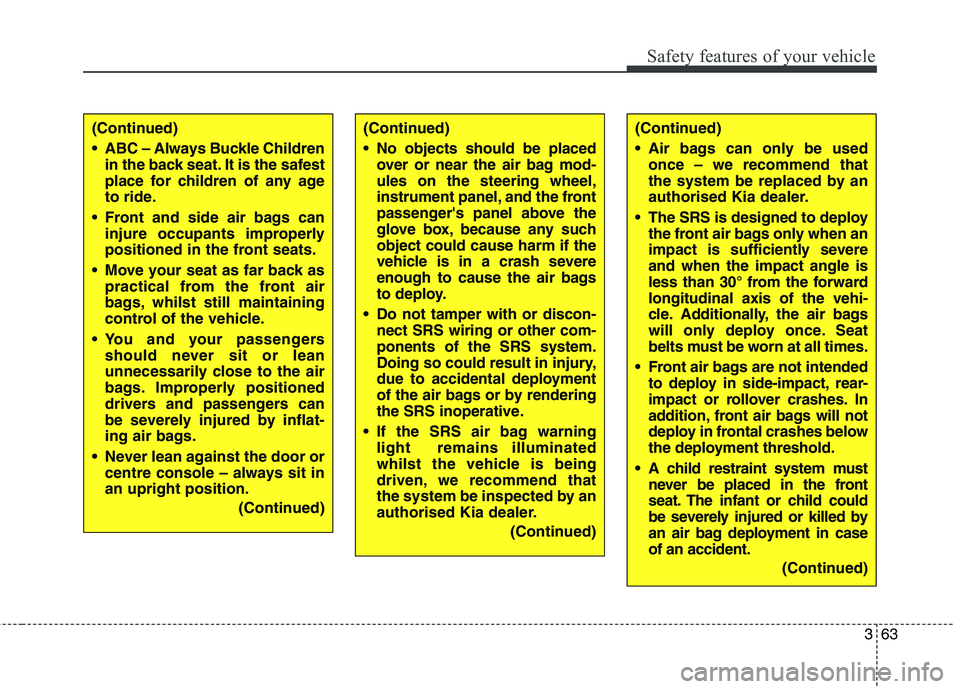
363
Safety features of your vehicle
(Continued)
ABC – Always Buckle Childrenin the back seat. It is the safest
place for children of any age
to ride.
Front and side air bags can injure occupants improperly
positioned in the front seats.
Move your seat as far back as practical from the front air
bags, whilst still maintaining
control of the vehicle.
You and your passengers should never sit or lean
unnecessarily close to the air
bags. Improperly positioned
drivers and passengers can
be severely injured by inflat-
ing air bags.
Never lean against the door or centre console – always sit inan upright position.
(Continued)(Continued)
No objects should be placedover or near the air bag mod- ules on the steering wheel,
instrument panel, and the front
passenger's panel above the
glove box, because any suchobject could cause harm if the
vehicle is in a crash severe
enough to cause the air bags
to deploy.
Do not tamper with or discon- nect SRS wiring or other com-ponents of the SRS system.
Doing so could result in injury,
due to accidental deployment
of the air bags or by rendering
the SRS inoperative.
If the SRS air bag warning light remains illuminated
whilst the vehicle is being
driven, we recommend that
the system be inspected by an
authorised Kia dealer.
(Continued)(Continued)
Air bags can only be usedonce – we recommend that
the system be replaced by an
authorised Kia dealer.
The SRS is designed to deploy the front air bags only when an
impact is sufficiently severeand when the impact angle is
less than 30° from the forwardlongitudinal axis of the vehi-
cle. Additionally, the air bags
will only deploy once. Seat
belts must be worn at all times.
Front air bags are not intended to deploy in side-impact, rear-
impact or rollover crashes. In
addition, front air bags will not
deploy in frontal crashes below
the deployment threshold.
A child restraint system must never be placed in the front
seat. The infant or child could
be severely injured or killed by
an air bag deployment in caseof an accident.
(Continued)